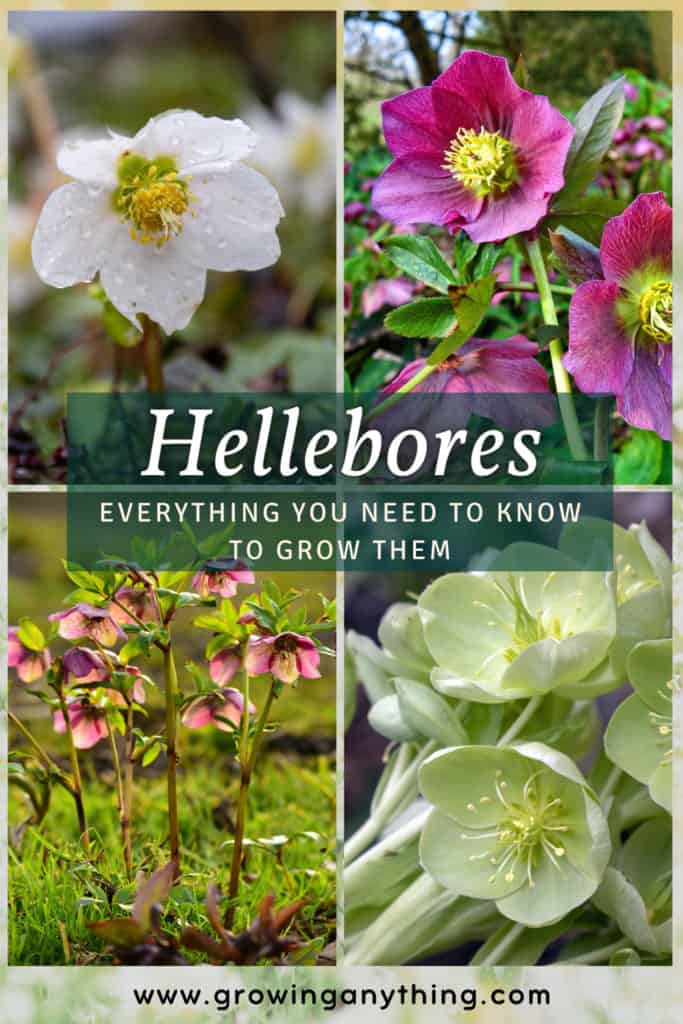What are Hellebores?
Hellebores are simple to grow but wonderfully rewarding plants. They look beautiful from January to May, and some associate them with the end of the winter.
Hellebores blossom early and come in different flower colors, and require just simple care.
I will cover the essential aspects of hellebores in the article, including varieties, growing tips, and propagation.
You can learn everything about growing hellebores in the garden or pots, indoors.
But, before we move on to the growing guide, let’s see more about this beautiful and practical plant.
What Kind of Plants are Hellebores?
Hellebores name refers to different plants that belong to the Ranunculaceae family, genus Helleborus. The family also includes monkshood, anemone, and delphinium.
Plant collectors only grew hellebores in the past. But creating hybrid plants makes them more popular and available for home gardens.
These plants grow in Zone 5 to 8 and have a decorative purpose. Most people choose these plants for their frost-resistance properties and evergreen foliage. They also grow well in the shade, which makes them perfect for filling dark spots in gardens.
Hellebores come in different colors and are attractive to bumblebees.
How Hellebores Look?
Hellebores have multifarious sepals and downward-facing flowers.
Their foliage is evergreen and grows in low clumps with lobed leaves. The leaves have a palm-like shape and make the plant look attractive even when there are no flowers. The flowers are like roses, with stems poking above the leaves. The blooming season is long, and most hellebores have pink, white, or purple-colored flowers.
Hybridization created more flower colors, so you have more options for your garden.
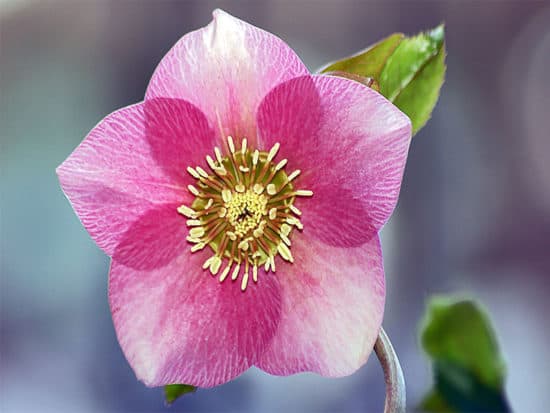
Are Hellebores Poisonous?
Hellebore contains the toxin protoanemonin, so it is poisonous when ingested. Ingesting large amounts of plants is severely toxic but rare.
Because the plant has an unpleasant bitter taste, not even animals won’t feed on it. Therefore, your hellebores are safe from deer and rabbits.
If a person ingests any part of the plant, the burning in the mouth and through will happen, followed by vomiting, salivation, abdominal pain, depression, diarrhea, and other symptoms.
Physical contact with the plant can irritate your skin. Therefore, I recommend you to wear gloves when you work around and with the plant.
Top 10 Hellebore Varieties to Consider for Your Garden
There are many varieties in hellebore that come in a complete color range. Choosing the most beautiful one can be a tough choice. So, here is a simple guide covering the best hellebore varieties.
Corsican Hellebore
The Corsican hellebore isn’t known for its flowers, but beautiful lush foliage. The flowers are smaller and come in a pretty pale green shade.
Ivory Prince
Ivory prince hellebores have delightful ivory flowers. Each flower features chartreuse and pale veining across the petals. The Ivory prince foliage isn’t as rich as the flowers, but it makes a stunning contrast with ivory flowers. Overall, the plant is small and a splendid choice for tight spaces.
Winter Jewels
Several subspecies belong to the Winter Jewels variety. They come in a different range of colors and are the most popular across the USA. The other name for it is Lenten rose.
Some of the subspecies are:
- Cherry Blossom – flowers are white or pink and have red centers
- Golden Sunrise – yellow flowers
- Apricot Blush – White petals with apricot shade tingling on the petals
- Black Diamond – purple leaves that turn green as the plant mature, dark burgundy flowers
Ruse Black
Ruse black is the most dramatic hellebore variety with black flowers with white centers and stunning spot-free foliage.
The petals are large and symmetric. Ruse black comes from Japan and can be grown in zones 3-9.
Fragrant Hellebore
People grow fragrant hellebores for aroma and pretty display. They have large flowers in lime or yellow color with a sweet and spunky fragrance.
Picotee Lady
These hellebores have white and green flowers with pink veining. Each petal has dark red borders and looks stunning.
Double Ladies
Double ladies hellebores are one of the double-flowered varieties. They are available in different colors and shades of pink, yellow, purple, but you can white double ladies, too.
Christmas Rose
The Christmas rose or Helleborus niger blossoms in winter and spring. The plant is native to the Alps and parts of Italy and Germany.
Christmas rose has dark green foliage with nine leaflets and pinkish flower buds. Once the flowers are open, they show a stunning white and green center.
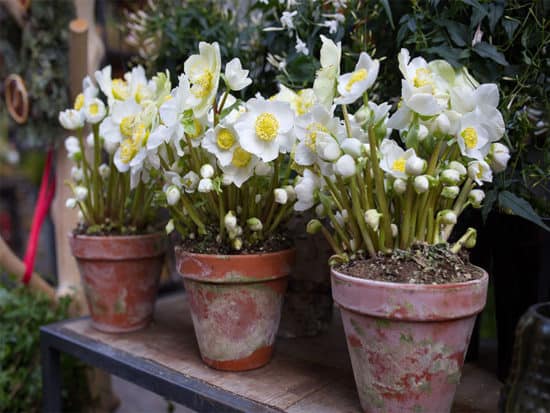
Blue Lady
The Blue Lady variety is different from most other hellebores because its flowers face upwards and not downwards. The plum flowers have blue tones, and the evergreen foliage is deep green.
Mrs. Betty Ranicar
If you are looking for double-flowered hellebores, you can check the Mrs. Betty Ranicar variety. These flowers are ruffled and have a pure white shade. It is best when you grow in from seeds.
How to Start Hellebores in Your Garden?
Hellebores are hardy plants in zones 3 – 9 which don’t need much maintenance. But, to ensure that your plants grow to their full potential, you can start on the right track and ensure optimal growing conditions.
Ways to Start Hellebores in Your Garden
There are two ways to start growing hellebores in the garden. All three techniques are successful when completed well, so your choice depends on your personal preferences.
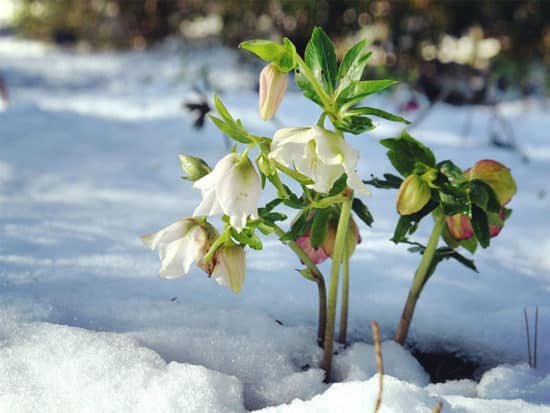
Growing Hellebores From the Seeds
Hellebore hybrid seeds aren’t true which means they won’t grow exactly the same as the parent plants. However, it means that you can get plants with different characteristics in a different range of colors. It can be one of the disadvantages when growing hellebores from the seeds.
Also, the plants raising from the seeds may come as double, with one row of petals around the center, or two petal rows.
You can also expect petals to be ruffled or have different markings.
I recommend buying the seeds from a local gardening center if the colors aren’t important to you.
Sowing Process
Once you purchase the seeds, sow them as soon as possible. Choose the location where you can ensure at least 18 inches of depth, which should be enough for plants to develop a healthy root system. Before, you plant loose the soil with a garden fork to get the crumbly structure.
Hellebores grow best when started in well-prepared garden beds.
Measure the width of the seed and plant them in-depth, which is two times the width of the seed. When you sow the seeds too deeply, it will postpone germination or cause the root system to rot.
However, you can sow the seeds simpler. Water the soil gently and sprinkle the seed. Then, press the seeds down in the ground.
You can also cover the seeds with sand or fine gravel to prevent fungal growth.
Transplanting Hellebores from Nurseries
You can buy hellebores from local nurseries during the blooming season – late winter to spring. It is also an excellent choice for people looking for a specific flower color to choose the variety they like.
Additionally, some nurseries offer discounts on hellebores during mid-summer, after the blooming season. You can get those and plant them without any issues.
You should transplant hellebores as soon as they arrive. But, if it is too cold for transplantation, you need to remove flower stamens and fallen petals every day until you are ready to transplant.
Removing dead parts of the plant reduces the risk of grey mold that can happen in the winter. If the delay prolongs, you can use a fungicide to prevent fungal problems.
Also, if you transplant the plant and it gets frozen, don’t worry. Once the frost passes, the plant will defrost and recover slowly.
Transplanting
Hellebores come in temporary nursery containers. Once you get the plant, you can transplant it to the chosen location in the garden.
The process is relatively simple, take the plant from the soil and place it into the hole you dug up for it.
The hole shouldn’t be too deep, as it can affect blooms. The crown should only be covered with the soil lightly.
Don’t forget to wear gloves while transplanting the plant to avoid skin dermatitis.
When to Plant Hellebores?
You can plant hellebores any time you want. Late winter and early spring are the best for planting hellebores because you have the widest range of varieties to choose from for your garden.
On the other hand, if you plant hellebores in the fall, the plants will have enough time to develop strong roots in the warm soil until cold temperatures come. The same applies to planting in the late spring.
But, the planting time won’t affect the growing success.
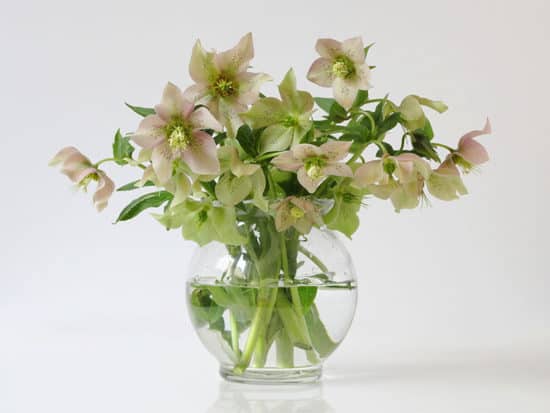
Where to Plant Hellebores?
Hellebores prefer well-draining soil. Conveniently, hellebores aren’t picky for the light. They can grow well in full sun or full shade, which makes great plants to use for garden landscaping.
Also, if you are planting more plants at once, spread them with 18 inches between each one. That way, the roots will have enough space to develop.
Soil Quality
Hellebores successfully grow in humus soil. They are very resilient plants, as they can tolerate drought.
To make your plants drought tolerant, water them thoroughly during the first year. After that, the plants will be drought-resistant for years.
But, there is a catch.
Remember, the trick is to plant hellebores in well-draining soil. If you overwater the plants and the soil becomes bogy, hellebores may die.
How much Water Hellebores Need?
Hellebores aren’t challenging to maintain. Most plants will get enough water via rain.
Just like with other perennials, watering after planting is useful. Once you planted hellebores, apply just enough water to keep the 1-inch layer of soil below the surface damp.
The easiest way to check if the soil is wet enough is to stick your finger.
After that, hellebores only need 1 inch of water per week, similar to other perennial plants. If you live in a rainy area, you might not even need to water your plants because the rain will do it for you.
Additionally, I recommend watering hellebores in the morning, especially if you doubt the soil-drainage properties. That way, the soil will have enough time to dry.
Using a rain gauge is a useful way to see if the plant needs water.
What About Fertilization?
Even though hellebores are referred to as simple-maintenance plants, they require fertilization in their growing cycle. The fertilization choice and timing are important for producing flowers and remaining healthy.
Hellebores require slow-release fertilizer when you plant them in the spring during the first year. When the plant starts producing flower buds, it may need an extra shot of nitrogen and iron. You can feed the plant with a liquid drench.
You can also use calcified fertilizer or slow-release phosphate fertilizer to strengthen the roots and establish the plant.
Does Hellebores Need Mulch?
I recommend amending the soil with a mulch layer annually, about the time when the plant makes flower buds for the next blooming season.
You can also mulch in late December to prepare the plant for harsh temperatures.
When mulching, avoid mulching in the plant crown cause it can make buds rot.
Do Hellebores Require Pruning?
Hellebores require pruning, but luckily it isn’t complex as it is with some other plants.
You should prune hellebores in late winter or spring. The exact time for pruning depends on the growing habits of your plants.
Hellebores are evergreen plants, so the old year’s growth is visible when the new one appears. When you notice new growth is a sign that the plant needs to be pruned.
You can easily recognize new growth as it comes poking from the ground as thin stalks. Sometimes, last year’s leaves surrounded the stalk, making it impossible to notice fresh growth. If your hellebore is bushy, you can inspect it once a week for new growth in late winter until you learn it is ready for pruning.
You have cut old leaves just at the base. Leaving the old growth for too long will cause new and old foliage to get tangled and more difficult to trim.
Also, it can affect the airflow and lead to fungal disease, snails, and slugs.
Remember to prune old growth precisely and as close to the stem as possible. You can use a sharp knife or pruning shears to complete it.
Because you will touch parts of the plant, wear protective gloves and remove the debris as soon as you finish pruning.
Don’t forget to clean the pruning shears, as the toxin may linger to them.
How to Propagate Hellebores?
Hellebores are self-sowing plants, and they will propagate around your garden. As I mentioned before, new plants won’t look identical to their parents, and they can ruin the flower display in your garden. You can pot them and share with friends and family, destroy them or use the plants for composts.
However, if you propagate the hellebores by yourself, you will have more control over the plants and you can plan the garden display.
There are two ways to propagate hellebores – division and seedlings.
Division
The division ensures to have an exact look at the plant you want. You have to perform cuts all the way through a thick rhizome. That way, you will separate the main plant into several other individual plants.
To divide your hellebores, you can start by watering the soil. Prepare a shovel with a 12-inch blade, and dig a ring around the plant. The distance between the plant and the ring should be approximately 8 inches.
Water the plant lightly to moisten the soil.
Dig the ground until the plant is completely free. You can use a garden claw or your hands to loosen the soil on the roots. Be gentle and don’t expose roots completely, as it can damage them.
Just clean the roots so you can see where the stems meet the roots, which is the crown.
Identify the rhizome, the root with the stems, and use pruners to cut the rhizome.
Make sure that each cut contains at least one stem, rhizome part, and more roots.
If you aren’t ready to transplant these cuttings immediately, place them in the water to prevent them from drying out.
You can transplant those plants in the garden, following the procedure I described earlier, in the transplanting section.
I recommend dividing hellebores in late fall.
Propagation via Seeds
To propagate hellebores via seed, you first need to harvest the seeds before the plant drops them on the ground for germination or for wind or wild animals to move them further.
There are four harvest methods for collecting hellebores seeds.
- Harvest Flower Heads
Harvesting the entire flower head is the simplest method. You can snip the flower head off with pruning shears directly into the bucket.
Spread the flower heads you collected on the newspaper and rub the seed pods to open them and collect seeds.
You can use flower leftovers for compost, and store seeds in a jar or envelope until you’re ready to plant them.
Additionally, you don’t have to cut entire flower heads. You can crumble them to collect the seed pods in the bucket. Then place the seed pods on the newspaper and repeat the process.
Collecting seeds this way is simple, but it lacks precision. The seedpods may fall on the ground and open as if the plant self-sow.
- Using the Bag
You can put bags over flower heads (or the plant). I recommend using small mesh bags, which won’t make small seeds fall through. The bags should be breathable and cover the entire flower head.
Once the seed pods start to appear, you can close the bag around the stem. Jiggle the bag every few days to collect seed pods.
The process is the same if you cover the entire plant.
After that, you hear the bag making a sound, it is a sign that you have already collected seed pods. Spill the bag content on the newspaper and remove the chaff from seeds.
Again, store the seeds in a dry container or envelope and use the chaff for compost. Collecting seeds with a bag reduces the risk of uncontrolled sowing. But, it works only in dry conditions.
If the weather is rainy while your plant is in the bag, the seeds will get moist and start to rot. Additionally, the bag technique may collect unripe seeds as well.
Wear protective gloves and plant the seeds as soon as possible to improve the germination process.
Can you Grow Hellebores in Pots?
It is possible to grow hellebores in pots, but there are several things to keep in mind to keep them healthy.
You can keep the hellebores in pots until you are ready to transplant them outside or keep them in containers year-round.
The pot choice is important because hellebores need well-draining and moist soil. You can use organic potting soil and compost to improve the soil quality in the pot.
Next, because the hellebores develop large roots, you need to find a large container. They don’t do well with transfers often.
The pot needs to be deep to accommodate long roots. Caring for hellebores in pots is a bit more challenging. You need to keep them in the window to ensure plenty of sun during winter and spring. In the summer, you can move them to a shady location.
Hellebores don’t like too hot room temperature. In the winter, place them in a slightly cooler room but with plenty of sun exposure.
Pests and Diseases
Hellebores are healthy plants, but few problems can occur. Let’s briefly go through potential hellebores problems.
Aphids
Aphids are the most common, and you can identify them by inspecting the inside of the flowers and the surface of young leaves. If you notice sticky matter, your hellebores are under the attack of aphids. You can try to wash them off using a garden hose or use a nontoxic neem oil spray.
Black Death
Black death is a relatively new disease that destroys hellebores. Scientists believe a virus causes it.
The symptoms are black streaks and spots on the foliage and flowers. It rarely attacks home plants and is more likely to happen in nurseries.
Still, if you notice the symptoms, you should dig the plant out and destroy it. How to Use Hellebores in Your Garden?
How to Use Hellebores in Your Garden?
Hellebores are pretty flowering plants that come in a variety of colors and grow in the shade. Therefore, you can use them in bald spots in your garden.
They look great with other early blooming spring flowers such as daffodils and ornamental grasses.
Hellebores flowers face downwards, and you can grow them on a slope for better effect. You can also plant them under deciduous trees and shrubs to add a burst of color to their blooming season.
Because of the color range, hellebores look beautiful when planted with other purple companions such as pulmonarias, cyclamen, the glory of the snow, Muscari, etc.
They also make beautiful cut flowers and stunning decorations when you put the flower head in the water bowl.
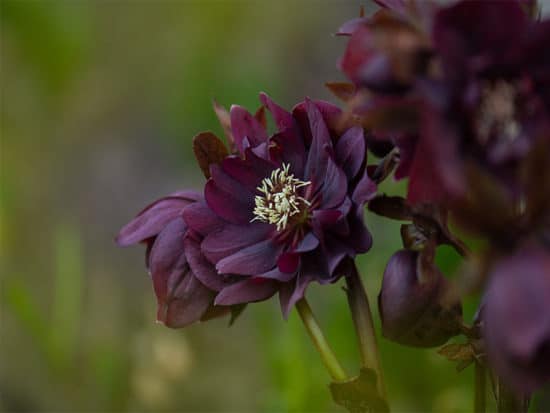
Hellebores – Colorful, Vigorous, and Maintenance-Free Garden Buddies
Hellebores are an easy way to improve the look of your garden. Because there are so many varieties and hybrids, the most challenging part of growing hellebores is the plant itself!
They come in different flower colors and shades – from pure white, through delicate pink, violet, blue, red, and burgundy to matte black.
Hellebores have just a few requirements to reward you with the most beautiful flowers in late winter – well-draining soil, good airflow, pruning, and proper fertilization.
How did you like my hellebore guide? If you have more hellebores growing tips, share them in the comments!
Don’t forget to like and share the article if you enjoyed it.
